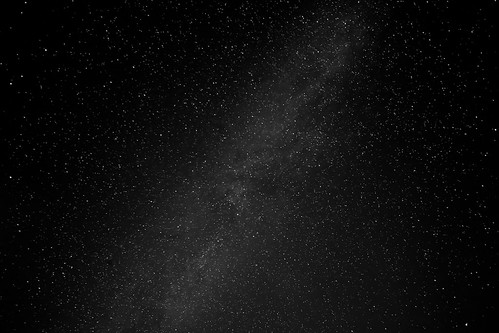Astrophotography: I don’t make a good beginner at things
November 9, 2010
Techniques of imaging the sky with some sort of camera progress from common sense to PhD within a single sentence. I know because I’ve spent weeks trying to find a conceptual, somewhat layman’s explanation of the basics, and keep getting mired in gearhead, Byzantine Web forums and scientific publications. I lament the absence of any sort of glossy, entry-level book explaining how to take photos of things in space at night, but I’ve come to realize that the reason that no such thing exists is that perhaps it cannot.
I attended a meeting tonight of the Rose City Astronomers Astro-Imaging Special Interest Group (as you can imagine, that compresses into multiple acronyms) at the enormous library in Beaverton. My ears, my brain, my psyche are still ringing.
What I realized by the end of the evening is that I’m not dealing with a branch of photography, by and large here. I’m dealing with physics. The problem set is not aesthetic, it’s mathematical. Banter is in wavelengths, ratios, narrow-band filters. Gear is hyper-specific. Club members rattled off tech specs of impressively chilled monochromatic CCD cameras that, despite their $3-4k price tag, have no lenses, storage, auto-focus or viewfinder, and often have to be plugged into the wall—a rather unfortunate situation because most astrophotography is done outdoors. Telescopes like ours (a Newtonian reflector about the size of a small hot water heater) are generally poo-poohed in favor of much more costly refractor variants.
An amusing curmudgeon with an accent that reminded me of Werner Herzog drove a couple of point home. These are truths according to him:
- Noise (of the visual kind) is my biggest enemy. OK, not a huge surprise.
- Having a Canon 5D Mark II doesn’t get me much more than having the cheapest DSLR made. Apparently. The noise improvements between the high-end consumer DSLRs and entry-level models (hardware-wise) are negligible enough to be dismissed. And having more pixels on the same-sized sensor is actually a disadvantage when photographing stars.
- Profoundly basic textual data about a mere 10% of the stars in our own galaxy (coordinates, magnitude and some other very simple information) will fill your hard drive. Hundreds of GB. Kind of puts it in perspective. There sure are a lot of stars. Billions and billions, even.
I’m starting from scratch here in a rather brutal way. We’ll see if I can hack it.
Recently Reviewed
Get the Books
Read my Reviews
Related Posts
- Knowledge and Travel: Pine Mountain Observatory, Messier Objects
February 16, 2010 - Jupiter Week: Wednesday: Delinquent moons
November 17, 2010 - Jupiter Week: Monday: Anthropomorphic Moons
November 15, 2010 - Jupiter Week: Thursday: Io, the little pustule of the sky
November 18, 2010 - Jupiter Week: Tuesday: That’s some velocity, little moon
November 16, 2010





